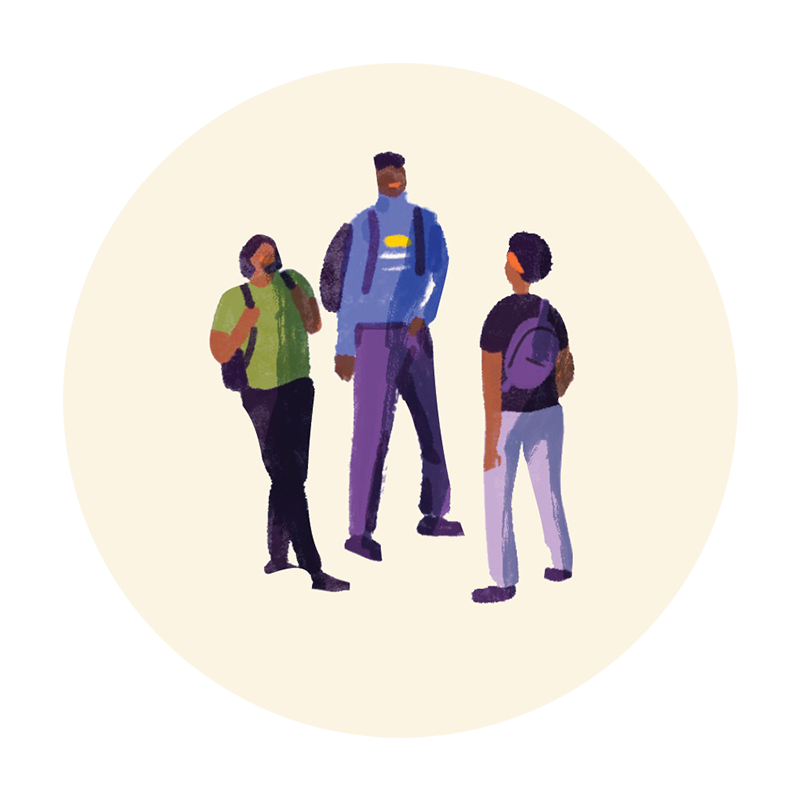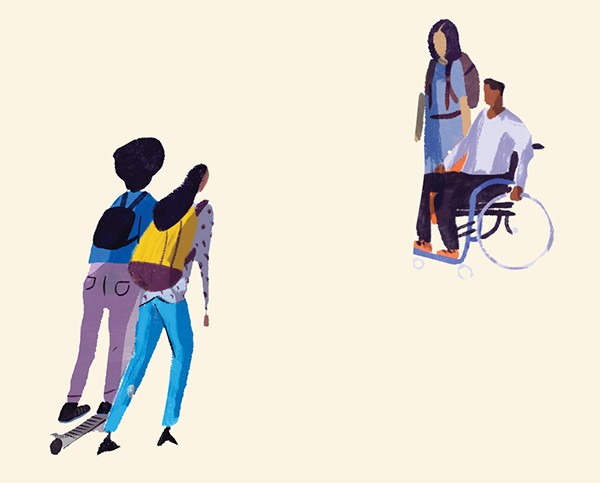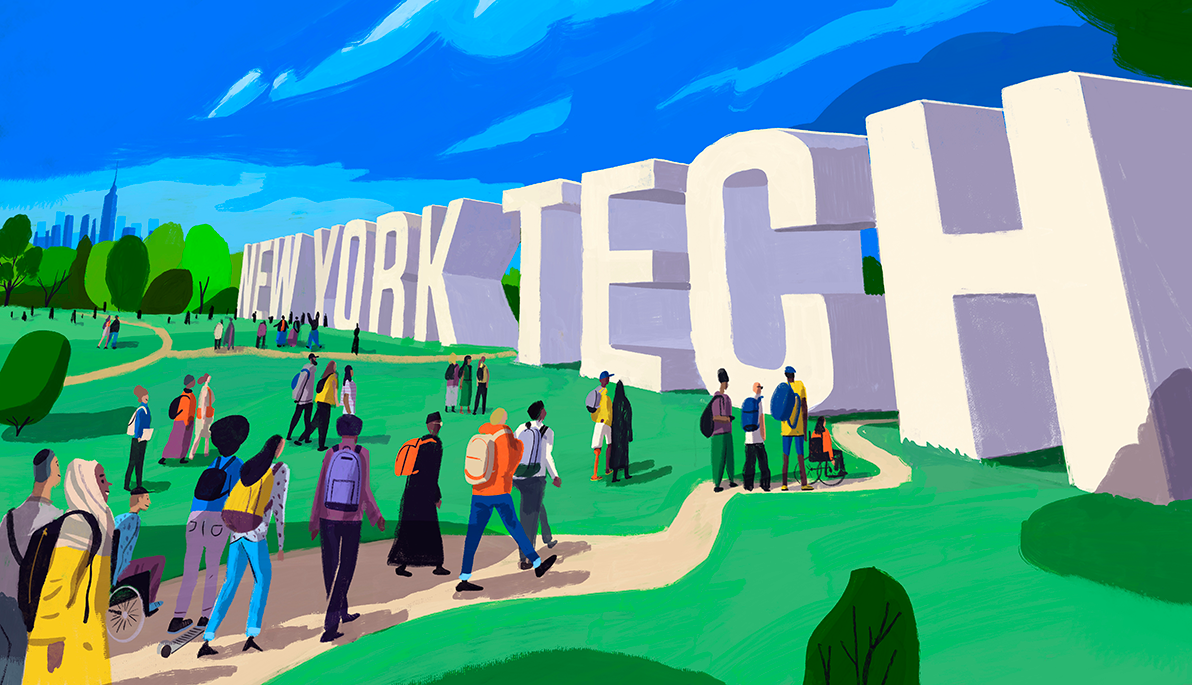News
You Belong
September 5, 2023

Across the nation, many colleges and universities have committed to increasing campus diversity. Despite their efforts, many of these institutions have not significantly changed their student enrollment or faculty composition. According to a recent analysis by consulting firm McKinsey & Company, it would take another 70 years at the current rate to recruit enough Asian, Black, Latinx, and Native American students for college enrollments to reflect America’s demographics.
But attracting a diverse student body hasn’t been a problem at New York Tech, where nearly three-quarters of undergraduate students and two-thirds of graduate students identify as non-white. The Wall Street Journal/Times Higher Education ranked New York Tech No. 2 in New York state and No. 8 in the United States for Environment, a pillar that measures inclusion, diversity, and international student representation. Diverse: Issues in Higher Education rated the College of Osteopathic Medicine as the top producer of minority graduates among colleges of osteopathic medicine in 2020–2021.
While many institutions would be satisfied by those statistics, New York Tech has doubled down on its commitment to diversity and inclusion, focusing on efforts to support its diverse student body, faculty, and staff to foster a sense of belonging and connection across its campuses.
“You can have a diverse population—and we have one of the most diverse enrollments nationwide—but for many reasons, students may not feel comfortable on campus and may not thrive the way we would like them to,” says Brian Harper, M.D., M.P.H., chief medical officer and vice president for equity and inclusion.
“Understanding the lived experiences and needs of the students we serve is crucial to our work in higher education”
Felipe Henao, Ed.D.
As an incoming biology student at New York Tech, it didn’t take Kaylah Dewar (B.S. ’23) long to realize she was one of the few Black female students in her major. When she changed her major to criminal justice, she became the only Black female in her classes. Although she found it difficult to relate to some of her peers, Dewar didn’t let being an “only” get in her way.
Instead, she joined the New York Tech Diversity, Equity, Inclusion, and Belonging (DEIB) advisory committee as a student leader on the Long Island campus. “I’m helping administrators see the school the way I see it,” she says. “My goal is to help ensure that every student’s voice and concerns on our campus are heard.”
According to Dewar, who served as president of the Black Student Union on the Long Island campus, inclusion comes in many forms, from the foods served in campus dining halls to the types of events held on campus. “The DEIB committee has made tremendous efforts to help the campus feel equal, diverse, and inclusive,” she says.
An Institutional Priority
Those efforts began in 2018, when New York Tech launched the Diversity, Equity, and Inclusion (DEI) Task Force. Recognizing its diversity as a strength to foster, the task force was charged with developing strategies to promote a culture of inclusion that offers all community members access to a meaningful teaching, learning, and working environment.

Out of that work came the recognition that to be truly effective, those efforts needed to be fully institutionalized. Harper, who chaired the committee, was named the school’s first vice president for equity and inclusion in January 2021. In October 2022, New York Tech created the Office of Diversity, Equity, Inclusion, and Belonging, and the task force transitioned into the DEIB advisory committee.
“We are institutionalizing efforts to create that sense of belonging so that everyone in our community can reach their full potential,” says Harper. “Ultimately, we want all departments and colleges to take on diversity, equity, and inclusion as something that they incorporate as a matter of routine into their operations.”
Harper’s initial goals were to educate the entire campus community on DEI issues and to conduct a survey to learn about specific concerns and perspectives about New York Tech on matters of DEI.
Last spring, faculty and staff across all campuses completed an online DEI training module. “It’s important that everybody is on the same page in understanding the dynamics we’re talking about and the terminology we’re using,” he says.
Following the training, the entire New York Tech community—students included—was invited to complete a campus climate survey about their own impressions and experiences related to diversity and belonging on campus. “We had no idea what we would get back and were somewhat pleased that people were fairly comfortable with the environment at New York Tech,” he says.
But there’s always room to improve and to lead. Dewar says a series of small changes implemented across campus have already made a meaningful impact for students, including the addition of gender-neutral bathrooms on the New York City and Long Island campuses, the adoption of a preferred-name policy that allows students to use a first name other than their legal name, and increased outreach and support for the university’s identity-based clubs.
“Understanding the lived experiences and needs of the students we serve is crucial to our work in higher education,” says Felipe Henao, Ed.D., dean of students and co-chair of the DEI Advisory Group and Committee. “Systemic change won’t happen until we start inviting and involving all parties and voices around the table and talking more to one another in our shared spaces.”
Dialogue and Outreach
Henao draws from his own experiences as a first-generation Latino college student who attended a predominantly white institution. After joining New York Tech as dean of students for both the Long Island and New York City campuses in 2021, he was intentional about working with the organizations that represent various interests, from the Bengali Student Association and Black Student Union to LGBTQ organizations. “My office coordinated listening sessions with every single group so we could hear directly from students about their experiences, both good and bad,” he says. “Students will not feel valued or supported unless you’re intentional about the collaborations and the relationships and the trust that you build.”

While diversity is often associated with skin color or cultural background, Henao stresses that New York Tech sees DEIB through a wider lens, incorporating religious differences, sexual orientation, gender, socioeconomic background, learning differences, and veteran status. “There are populations that go day to day being unnoticed or experiencing microaggressions, and we want to make sure we are providing opportunities for them to be seen, valued, heard, and included.”
Some of that work begins before students set foot on campus. Harper has placed a priority on developing community partnerships. During his 20 years working in public health capacities to reduce health disparities, he witnessed the difference a community organization or church could make in getting patients to trust a medical organization or treatment. The same is true with higher education, he says.
“We’ve expanded our outreach to build and maintain relationships with high schools and other organizations in historically underrepresented communities,” Harper says. “If we’re an active part of helping them with their community efforts, we become more visible, and the organization is more likely to recommend our institution. Those relationships can also become a vehicle for internships or mentorship for students.”
But Harper is also being proactive in that regard through the creation of a DEIB Alumni Advisory Committee. Similar to alumni boards that advise New York Tech’s schools and colleges, Harper is recruiting successful alumni of color to serve in an advisory role to his office as well as in a mentorship capacity to students. “We envision this as a group we can draw from for campus speakers, to facilitate corporate visits and internships, and to provide individual mentorship to students. It’s sometimes easier for students to imagine their own success when they see and hear from people with backgrounds similar to their own.”
Harper views New York Tech’s diversity as an important strength, particularly at a time of nationwide divisiveness. “Having the opportunity to learn and grow from people different from ourselves and to understand other cultures and beliefs is an exceptional opportunity,” he says. “It can only help students as they navigate their lives and their careers.” around the table and talking more to one another in our shared spaces.”

This article originally appeared in the Spring 2023 issue of New York Institute of Technology Magazine.
By Renée Gearhart Levy




